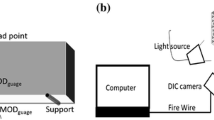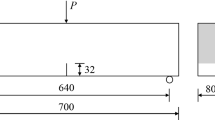Abstract
Fatigue tests were carried out on notched microconcrete beams subjected to three-point bending tests in a saturated atmosphere.
The feature of the crack growth was studied by means of the replica technique associated with scanning electron microscopy, in conjunction with the measurement of the crack mouth opening displacement (CMOD). Two domains must be distinguished in which the fatigue can be considered, depending on the upper boundary of the cyclic load. Beyond a given threshold for the upper boundary of the cyclic load, the first cycle induces an actual crack at the tip of the artificial notch. Observations of fatigue crack propagation are presented in that case and compared with previous investigations in static tests. The influence of the load level on the crack growth rate is discussed.
Résumé
Des essais de fatigue ont été réalisés sur des éprouvettes encochées de microbéton, en flexion trois points sous atmosphère saturée.
La topographie de la croissance de fissure a été observée au microsope électronique à balayage par la technique de la réplique, couplée avec la mesure de l'ouverture de la fissure.
Deux domaines de comportement à la fatigue, dépendant du niveau maximal de charge doivent être distingués dans de tels essais de fatigue. Au delà d'un seuil de charge, le premier cycle provoque déjà l'ouverture d'une fissure réelle à la pointe de l'encoche artificielle. Les observations de la propagation de fissure par fatigue sont menées dans ce cas. L'influence du niveau de charge sur la vitesse de propagation est aussi étudiée.
Similar content being viewed by others
Abbreviations
- Rt28 :
-
Tensile strength at the age of 28 days
- Rc28 :
-
Compressive strength at the age of 28 days
- Fu :
-
Mean value of the peak load in static tests
- Fmax :
-
Value of the maximum load in fatigue test
- Fmin :
-
Value of the minimum load in fatigue test
- δ:
-
Deflection of the upper fibre
- Δ:
-
Crack mouth opening displacement (CMOD)
- a:
-
Projected crack length
- n:
-
Number of cycles
- N:
-
Number of cycles to failure
References
Bažant, Z. P. and Xu, K. ‘Size effect in fatigue fracture of concrete’,ACI Materials Journal 88 (4) (1991) 390–399.
Bažant, Z. P. and Schell, W. ‘Fatigue fracture of high strength concrete and size effect’,90 (5) (1993) 472–478.
Hordijk, D. A., ‘Local Approach to Fatigue of Concrete’, Technical Thesis of University Delft (1990).
Hsu, T. T. C., ‘Fatigue and microcracking of concrete’,Mater. Struct. 17 (97) (1984) 51–54.
Horii, H., Shin, H. C. and Pallewatta, T. M., ‘Mechanism of fatigue crack growth in concrete’,Cement and Concrete Composites 14 (2) (1992) 83–89.
Akutagawa, S., Jeang, F. L., Hawkins, N. M., Liaw, B. M., Du, J. and Kobayashi, A. S., ‘Effects of loading history on fracture properties of concrete’,ACI Materials Journal 88 (2) (1991) 170–180.
Shi, X. P., Fwa, T. F. and Tan, S. A., ‘Flexural fatigue strength of plain concrete’,90 (5) (1993) 435–440.
BAEL 91., ‘Règles techniques de conception et de calcul d'ouvrages en béton armé’ (Cahiers du CSTB, 1992).
Shah, S. P. and Carpinteri, A., ‘Fracture Mechanics, Test Methods for Concrete’, RILEM Report 5 (Chapman and Hall, 1991).
Ollivier, J. P., ‘A non destructive procedure to observe the microcracks of concrete by scanning electron microscopy’,Cement and Concrete Research 15 (6) (1985) 1055–1060.
Ringot, E., ‘Development of the map cracking in concrete under compressive loading’,18 (1988) 933–942.
Bascoul, A. and Turatsinze, A., ‘Microstructural characterisation of mode I crack opening in mortar’,Mater. Struct. 27 (166) (1994) 71–78.
Galloway, J. W., Raithby, K. D. and Harding, H. M., ‘Effects of moisture changes on the flexural strength and fatigue performance of concrete’, Report LR 864, 1979.
Karihaloo, B. L., ‘Fracture Mechanics and Structural Concrete’, (Longman Scientific & Technical, 1995).
Rossi, P., Ulm, F. J. and Hachi, F., ‘Compressive behavior of concrete: Physical mechanisms and modelling’,ASCE Engineering Mechanics (1994) 1–32.
‘Long term random dynamic loading of concrete structures’, RILEM Report Technical Committee 36-RDL,Mater. Struct. 17 (97) (1984) 1–29.
Paris, P. C. and Erdogan, F., ‘A critical analysis of crack propagation laws’.J. Basic Engineering (December 1963) 528–534.
Brown, W. E. and Strawly, J. E., ‘Plain strain crack toughness testing of high strength metallic materials’, Special technical publication ASTM, Philadelphia, 1967.
Binsheng, Z., Zhaohong, Z. and Keru, W., ‘Fatigue rupture of plain concrete analysed by fracture mechanics’, in ‘Fracture of Concrete and Rock’, Proceedings of an International Conference, Houston, June, 1987 (Springer-Verlag, New York, 1989) 58–63.
Baluch, M. H., Quresh, A. B. and Azad, A. K., ‘Fatigue crack propagation in plain concrete’, in ) 80–87.
Alliche, A. and Francois, D., ‘Fatigue damage of concrete’, in ) 88–95.
Author information
Authors and Affiliations
Additional information
Editorial Note Prof. Alain Bascoul is a RILEM Senior Member and a member of Technical Committee 148-SSC, “Test Methods for the Strain Softening Response of Concrete”.
Rights and permissions
About this article
Cite this article
Toumi, A., Bascoul, A. & Turatsinze, A. Crack propagation in concrete subjected to flexuralcyclic loading. Mat. Struct. 31, 451–458 (1998). https://doi.org/10.1007/BF02480468
Received:
Accepted:
Issue Date:
DOI: https://doi.org/10.1007/BF02480468




